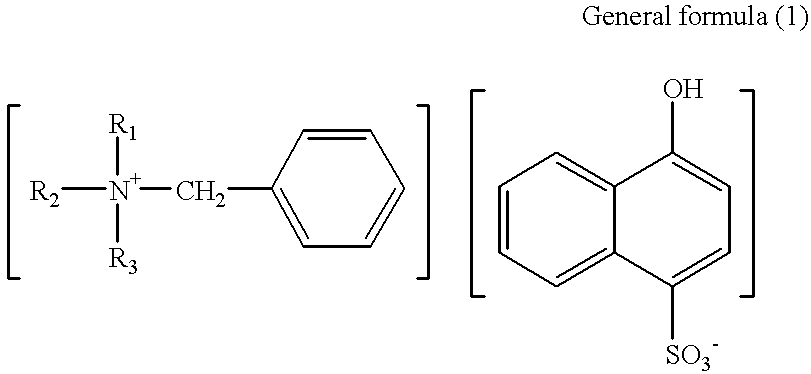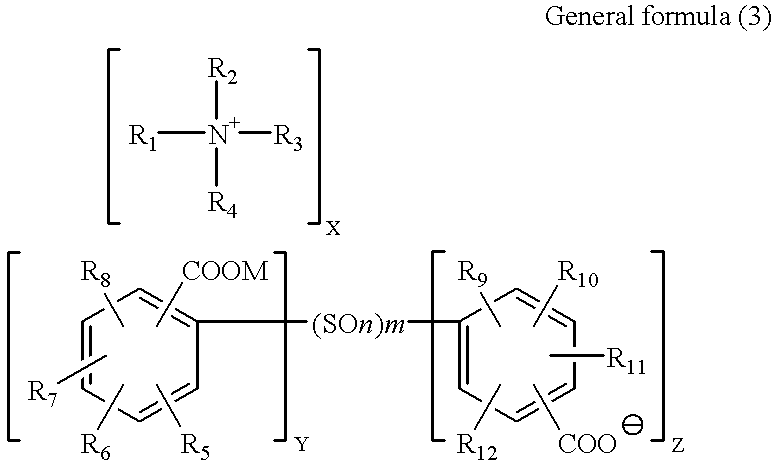Developer for electrostatic image development and image forming method using the same
a technology of electrostatic image and development method, applied in the direction of developers, optics, instruments, etc., can solve the problems of poor charging property of the carrier, poor reproducibility of fine lines, imperfect image,
- Summary
- Abstract
- Description
- Claims
- Application Information
AI Technical Summary
Benefits of technology
Problems solved by technology
Method used
Image
Examples
synthesis example 1
Resin Synthesis Example 1
[0084]
1 Terephthalic acid 2.0 parts by mol Isophthalic acid 2.5 parts by mol Trimellitic acid 0.5 parts by mol Polyoxyethylene-(2.0)-2,2- 4.0 parts by mol bis(4-hydroxyphenyl)propane Ethylene glycol 1.2 parts by mol
[0085] The starting materials described above were charged in a four-necked flask equipped with a stirrer, a condenser, and a thermometer, and dibutyltin oxide was added thereto in an amount of 0.07 parts by weight relative to the total weight of the total acid ingredients, in a stream of nitrogen gas. The reaction was carried out for 15 hours at 220.degree. C., while the water produced by dehydration condensation was being removed. The obtained polyester resin had a softening point of 155.degree. C., determined by the ring and ball type softening point measuring method, a Tg of 62.degree. C., determined by the DSC measuring method, and an acid value of 10.
synthesis example 2
Resin Synthesis Example 2
[0086] A polyester resin according to Resin Synthesis Example 2 was prepared in a manner similar to that of Resin Synthesis Example 1 employing the starting materials described below.
2 Terephthalic acid 2.5 parts by mol Isophthalic acid 2.5 parts by mol Trimethylolpropane 0.5 parts by mol Polyoxyethylene-(2.0)-2,2- 3.5 parts by mol bis(4-hydroxyphenyl)propane Ethylene glycol 1.0 parts by mol
[0087] The obtained polyester resin had a softening point of 150.degree. C., determined by the ring and ball type softening point measuring method, a Tg of 61.degree. C., determined by the DSC measuring method, and an acid value of 6.
synthesis example 3
Resin Synthesis Example 3
[0088]
3 Styrene 320 parts by weight Butyl acrylate 60 parts by weight Methacrylic acid 20 parts by weight Azobisisobutyronitrile 4 parts by weight Xylene 600 parts by weight
[0089] The starting materials described above were introduced into a round-bottomed flask. The reaction was carried out for approximately 10 hours at 80.degree. C. under a nitrogen atmosphere, and subsequently, the reaction mixture was allowed to heat up to 130.degree. C., completing the polymerization. Subsequently, aluminum isopropoxide in an amount of 12 parts by weight was added thereto, and the mixture was reacted for approximately one hour. The reaction mixture was allowed to heat up to 180.degree. C. under a reduced pressure of 0.5 mmHg by means of a vacuum pump, removing the solvent.
[0090] The obtained chelating cross-linked styrene--acrylic resin had a softening point of 145.degree. C., determined by the ring and ball type softening point measuring method, a Tg of 61.degree. C., ...
PUM
 Login to View More
Login to View More Abstract
Description
Claims
Application Information
 Login to View More
Login to View More - R&D
- Intellectual Property
- Life Sciences
- Materials
- Tech Scout
- Unparalleled Data Quality
- Higher Quality Content
- 60% Fewer Hallucinations
Browse by: Latest US Patents, China's latest patents, Technical Efficacy Thesaurus, Application Domain, Technology Topic, Popular Technical Reports.
© 2025 PatSnap. All rights reserved.Legal|Privacy policy|Modern Slavery Act Transparency Statement|Sitemap|About US| Contact US: help@patsnap.com



